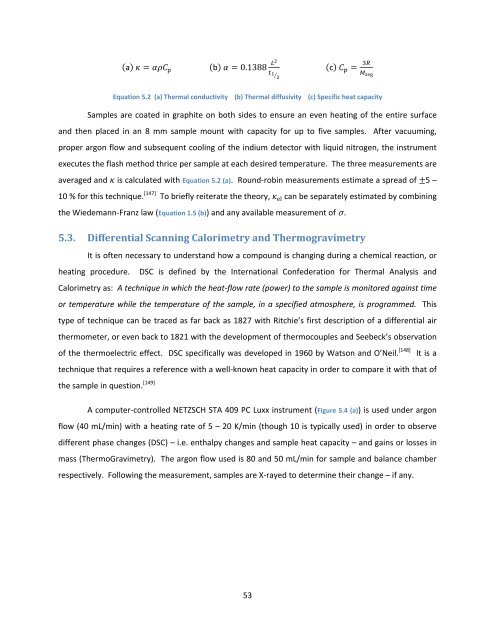Exploration and Optimization of Tellurium‐Based Thermoelectrics
Exploration and Optimization of Tellurium‐Based Thermoelectrics
Exploration and Optimization of Tellurium‐Based Thermoelectrics
Create successful ePaper yourself
Turn your PDF publications into a flip-book with our unique Google optimized e-Paper software.
a p b 0.1388 <br />
53<br />
c <br />
Equation 5.2 (a) Thermal conductivity (b) Thermal diffusivity (c) Specific heat capacity<br />
Samples are coated in graphite on both sides to ensure an even heating <strong>of</strong> the entire surface<br />
<strong>and</strong> then placed in an 8 mm sample mount with capacity for up to five samples. After vacuuming,<br />
proper argon flow <strong>and</strong> subsequent cooling <strong>of</strong> the indium detector with liquid nitrogen, the instrument<br />
executes the flash method thrice per sample at each desired temperature. The three measurements are<br />
averaged <strong>and</strong> is calculated with Equation 5.2 (a). Round‐robin measurements estimate a spread <strong>of</strong> 5 –<br />
10 % for this technique. [147] To briefly reiterate the theory, el can be separately estimated by combining<br />
the Wiedemann‐Franz law (Equation 1.5 (b)) <strong>and</strong> any available measurement <strong>of</strong> σ.<br />
5.3. Differential Scanning Calorimetry <strong>and</strong> Thermogravimetry<br />
It is <strong>of</strong>ten necessary to underst<strong>and</strong> how a compound is changing during a chemical reaction, or<br />
heating procedure. DSC is defined by the International Confederation for Thermal Analysis <strong>and</strong><br />
Calorimetry as: A technique in which the heat‐flow rate (power) to the sample is monitored against time<br />
or temperature while the temperature <strong>of</strong> the sample, in a specified atmosphere, is programmed. This<br />
type <strong>of</strong> technique can be traced as far back as 1827 with Ritchie’s first description <strong>of</strong> a differential air<br />
thermometer, or even back to 1821 with the development <strong>of</strong> thermocouples <strong>and</strong> Seebeck’s observation<br />
<strong>of</strong> the thermoelectric effect. DSC specifically was developed in 1960 by Watson <strong>and</strong> O’Neil. [148] It is a<br />
technique that requires a reference with a well‐known heat capacity in order to compare it with that <strong>of</strong><br />
the sample in question. [149]<br />
A computer‐controlled NETZSCH STA 409 PC Luxx instrument (Figure 5.4 (a)) is used under argon<br />
flow (40 mL/min) with a heating rate <strong>of</strong> 5 – 20 K/min (though 10 is typically used) in order to observe<br />
different phase changes (DSC) – i.e. enthalpy changes <strong>and</strong> sample heat capacity – <strong>and</strong> gains or losses in<br />
mass (ThermoGravimetry). The argon flow used is 80 <strong>and</strong> 50 mL/min for sample <strong>and</strong> balance chamber<br />
respectively. Following the measurement, samples are X‐rayed to determine their change – if any.<br />
avg
















